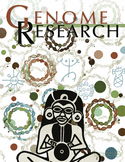Genome-wide relationship between histone H3 lysine 4 mono- and tri-methylation and transcription factor binding
- A. Gordon Robertson1,4,
- Mikhail Bilenky1,4,
- Angela Tam1,
- Yongjun Zhao1,
- Thomas Zeng1,
- Nina Thiessen1,
- Timothee Cezard1,
- Anthony P. Fejes1,
- Elizabeth D. Wederell2,
- Rebecca Cullum2,
- Ghia Euskirchen3,
- Martin Krzywinski1,
- Inanc Birol1,
- Michael Snyder3,
- Pamela A. Hoodless2,
- Martin Hirst1,
- Marco A. Marra1, and
- Steven J.M. Jones1,5
- 1 BC Cancer Agency Genome Sciences Centre, Vancouver V5Z 4S6, Canada;
- 2 Terry Fox Laboratory, BC Cancer Agency, Vancouver V5Z 1L3, Canada;
- 3 Department of Molecular, Cellular and Developmental Biology, Yale University, New Haven, Connecticut 06520, USA
-
↵4 These authors contributed equally to this work.
Abstract
We characterized the relationship of H3K4me1 and H3K4me3 at distal and proximal regulatory elements by comparing ChIP-seq profiles for these histone modifications and for two functionally different transcription factors: STAT1 in the immortalized HeLa S3 cell line, with and without interferon-gamma (IFNG) stimulation; and FOXA2 in mouse adult liver tissue. In unstimulated and stimulated HeLa cells, respectively, we determined ∼270,000 and ∼301,000 H3K4me1-enriched regions, and ∼54,500 and ∼76,100 H3K4me3-enriched regions. In mouse adult liver, we determined ∼227,000 and ∼34,800 H3K4me1 and H3K4me3 regions. Seventy-five percent of the ∼70,300 STAT1 binding sites in stimulated HeLa cells and 87% of the ∼11,000 FOXA2 sites in mouse liver were distal to known gene TSS; in both cell types, ∼83% of these distal sites were associated with at least one of the two histone modifications, and H3K4me1 was associated with over 96% of marked distal sites. After filtering against predicted transcription start sites, 50% of ∼26,800 marked distal IFNG-stimulated STAT1 binding sites, but 95% of ∼5800 marked distal FOXA2 sites, were associated with H3K4me1 only. Results for HeLa cells generated additional insights into transcriptional regulation involving STAT1. STAT1 binding was associated with 25% of all H3K4me1 regions in stimulated HeLa cells, suggesting that a single transcription factor can interact with an unexpectedly large fraction of regulatory regions. Strikingly, for a large majority of the locations of stimulated STAT1 binding, the dominant H3K4me1/me3 combinations were established before activation, suggesting mechanisms independent of IFNG stimulation and high-affinity STAT1 binding.
Footnotes
-
↵5 Corresponding author.
↵5 E-mail sjones{at}bcgsc.ca; fax (604) 876-3561.
-
[Supplemental material is available online at www.genome.org. The ChIP-seq data are available from www.bcgsc.ca/data/histone-modification.]
-
Article published online before print. Article and publication date are at http://www.genome.org/cgi/doi/10.1101/gr.078519.108.
-
- Received March 17, 2008.
- Accepted September 4, 2008.
-
Freely available online through the Genome Research Open Access option.
- Copyright © 2008, Cold Spring Harbor Laboratory Press











